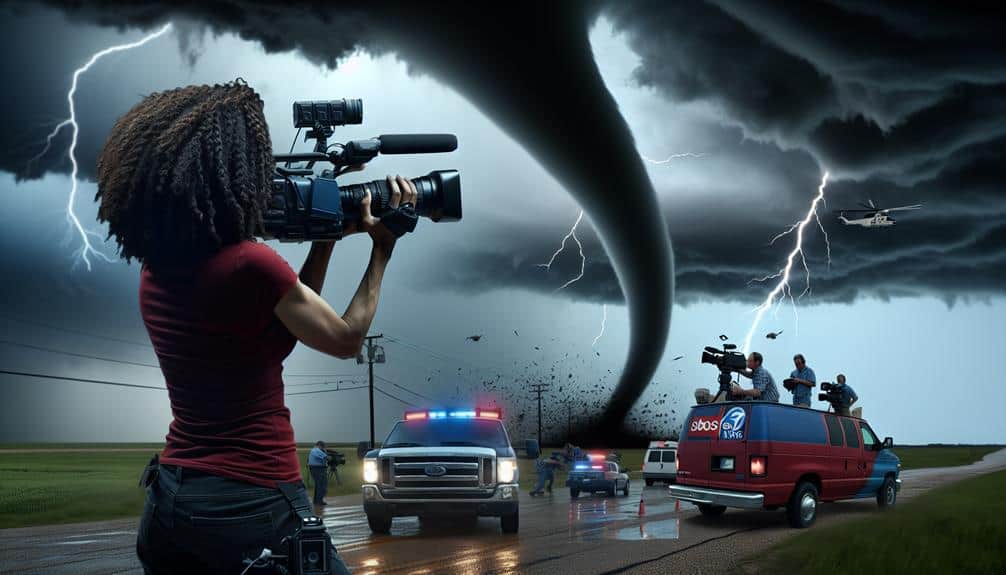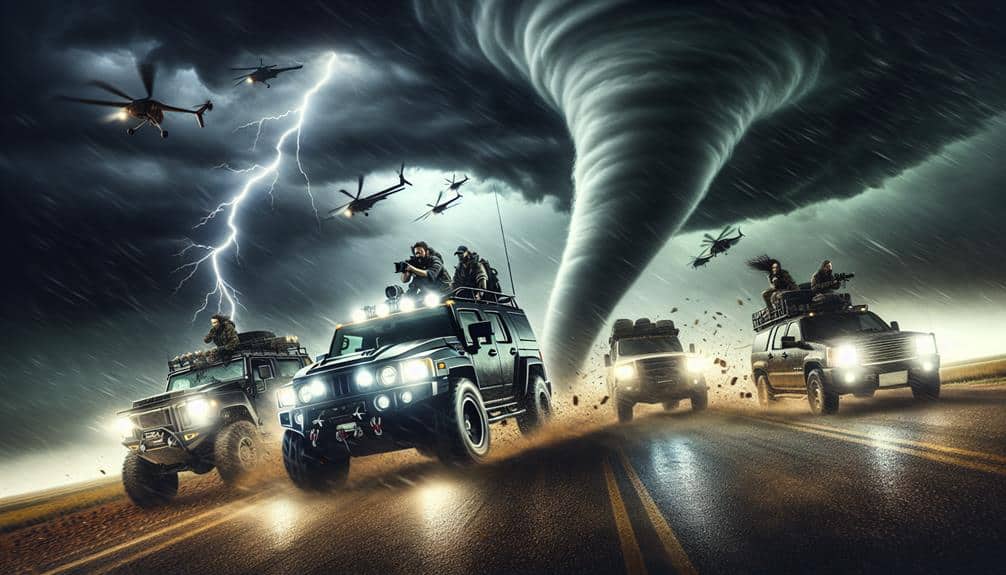Media greatly influences storm chasers by boosting public interest and financial support. As media coverage and reality TV shows pique curiosity, social media analytics highlight a surge in engagement during storm events. This heightened interest translates into expanded funding and sponsorship opportunities, with high-profile chasers securing brand endorsements, driven by their social media followings. The visibility provided by media allows for better technology and safety measures. Additionally, media exposure raises ethical considerations, such as environmental impact and privacy concerns. Thanks to these dynamics, storm chasers not only advance their technology and safety but also explore new professional opportunities.
Key Points
- Media coverage and reality TV shows have sparked a surge in public interest and engagement in storm chasing.
- Social media platforms provide real-time updates, sustaining interest and enabling interactive engagement with storm chasers.
- Increased visibility through media attracts sponsorships and funding, enhancing resources and safety measures for storm chasers.
- Ethical considerations and compliance with local regulations are influenced by media scrutiny and public expectations.
Increased Public Interest
The surge in public interest in storm chasing can be attributed to the extensive media coverage and the proliferation of reality TV shows showcasing storm chasers in action. These visual narratives have ignited a sense of curiosity among viewers, leading to increased engagement with storm chasing communities. Data indicates that media coverage has exponentially amplified public awareness and fascination with meteorological phenomena.
Social media plays an instrumental role in sustaining this interest. Platforms like Twitter, Facebook, and Instagram offer real-time updates and interactive content, allowing enthusiasts to engage directly with storm chasers. Metrics from social media analytics show a significant spike in engagement during storm events, with hashtags related to storm chasing trending frequently. This heightened engagement not only fuels public curiosity but also fosters a sense of community among storm chasing aficionados.
Moreover, the analytical data reveals that the democratization of information through social media has empowered individuals to participate in storm chasing activities more actively. By providing access to live feeds, expert analyses, and interactive maps, social media platforms have effectively bridged the gap between amateur enthusiasts and professional storm chasers, thereby driving the increased public interest in this exhilarating pursuit.
Funding and Sponsorship
As public interest in storm chasing surges, funding and sponsorship opportunities have simultaneously expanded, driven by media visibility and social media engagement metrics. Our ability to secure corporate partnerships hinges on our audience's reach and engagement, quantified by views, likes, shares, and follower growth rates.
High-profile storm chasers often attract significant brand endorsements, leveraging their platforms to market products ranging from weather gear to high-tech cameras.
Data indicates that storm chasers with substantial social media followings can command more lucrative partnerships. For instance, a chaser with 500,000 followers might secure a contract worth tens of thousands of dollars annually. These partnerships aren't just financial; they also provide essential equipment, such as advanced radar systems and communication devices, enhancing our operational capabilities.
Moreover, the symbiotic relationship between media coverage and sponsorship can't be overstated. Our media appearances boost visibility, which in turn attracts more sponsors. This cycle perpetuates our funding streams, allowing us to invest in better technology and safety measures.
Ultimately, these financial inflows fortify our mission, enabling us to chase storms more effectively while maintaining the freedom to explore nature's most formidable forces. In this ecosystem, media influence serves as the linchpin for sustainable storm chasing endeavors.
Ethical Considerations
Exploring the ethical landscape of storm chasing necessitates a thorough examination of our practices and their impact on both the environment and local communities. We must address privacy concerns, making sure that our pursuit of dramatic footage doesn't infringe on the personal lives of those in affected areas. Journalistic integrity demands that we balance the need for sensational stories with the responsibility of accurate, respectful reporting.
When it comes to emergency response, our presence can be a double-edged sword. On one hand, real-time data from storm chasers can significantly assist meteorologists and emergency services. On the other hand, our activities can inadvertently hinder rescue efforts, posing legal implications if we obstruct pathways or consume resources better used for crisis management.
Furthermore, the legal implications extend to compliance with local regulations and guidelines designed to safeguard both the chasers and the communities. Adhering to these legal frameworks not only protects us from potential liabilities but also reinforces our commitment to responsible storm chasing.
Technological Advancements
Recent technological advancements have revolutionized storm chasing, providing us with sophisticated tools like Doppler radar, high-resolution satellite imagery, and unmanned aerial vehicles (UAVs) to gather essential data with unprecedented accuracy. These innovations enable us to monitor storm development in real-time, enhancing our predictive capabilities and improving our overall safety measures.
Doppler radar, with its ability to detect wind patterns and precipitation intensity, allows for precise tracking of storm movements. This data is vital in determining the storm's potential path and intensity, enabling us to make informed decisions about positioning and escape routes.
High-resolution satellite imagery offers a broader perspective, capturing detailed atmospheric conditions and aiding in the identification of severe weather patterns from space.
UAVs have further expanded our reach, allowing us to collect data from the heart of storms without risking human lives. These drones provide high-resolution data on pressure, temperature, and humidity, which are crucial for understanding storm dynamics.
The research impact of these advancements is profound. By integrating data from these tools, we can develop more accurate models for storm prediction, ultimately contributing to the safety and well-being of communities at risk.
The freedom to explore with these technologies empowers us to push the boundaries of meteorological science.
Professional Opportunities

The rise of advanced meteorological technologies has opened up a myriad of professional opportunities for storm chasers, ranging from data analysis to emergency response coordination. Leveraging tools like Doppler radar and satellite imagery, we've seen substantial career growth in roles that require specialized knowledge in atmospheric dynamics. These advancements allow us to provide real-time data, which is vital for both scientific research and public safety.
Career growth in this field isn't just limited to traditional roles. Media coverage has amplified the demand for storm chasers in various sectors, including broadcast meteorology and climate consultancy. This exposure not only enhances our professional standing but also broadens our skill sets, making us valuable assets in multidisciplinary teams.
Networking opportunities have also expanded significantly. Conferences, webinars, and social media platforms enable us to connect with experts worldwide, fostering collaborative efforts and knowledge sharing. These connections often lead to new job prospects and partnerships, further propelling our professional development.
Frequently Asked Questions
How Do Storm Chasers Balance Safety With the Thrill of the Chase?
Balancing safety precautions with the adrenaline rush, we analyze meteorological data meticulously while ensuring our equipment's reliability. We prioritize safety by establishing escape routes, yet we don't let it dampen the excitement of chasing storms.
What Are the Most Dangerous Experiences Storm Chasers Have Faced?
We've faced deadly encounters and close calls, from tornadoes shifting unexpectedly to lightning strikes. Our survival stories underline the importance of risk assessment, balancing the thrill with safety protocols to navigate these extreme conditions effectively.
How Do Storm Chasers Prepare for Extreme Weather Conditions?
During a 2013 tornado chase, we followed strict emergency protocols and carried advanced survival gear, including GPS systems, weather radios, and first aid kits. We meticulously monitored data to make informed decisions and guarantee our safety.
What Training or Background Do Most Storm Chasers Have?
We focus on storm chasers' educational backgrounds in meteorology, emphasizing meteorology expertise. Most have hands-on training and extensive field experience, blending academic knowledge with practical skills to guarantee they're well-prepared for unpredictable and extreme weather conditions.
How Do Storm Chasers Handle Mental Stress and Trauma From Their Experiences?
Handling mental stress and trauma? Easy. We just binge-watch cat videos, right? Jokes aside, we employ coping mechanisms, rely on support systems, and prioritize mental health to build resilience. Data shows these methods greatly improve our well-being.


